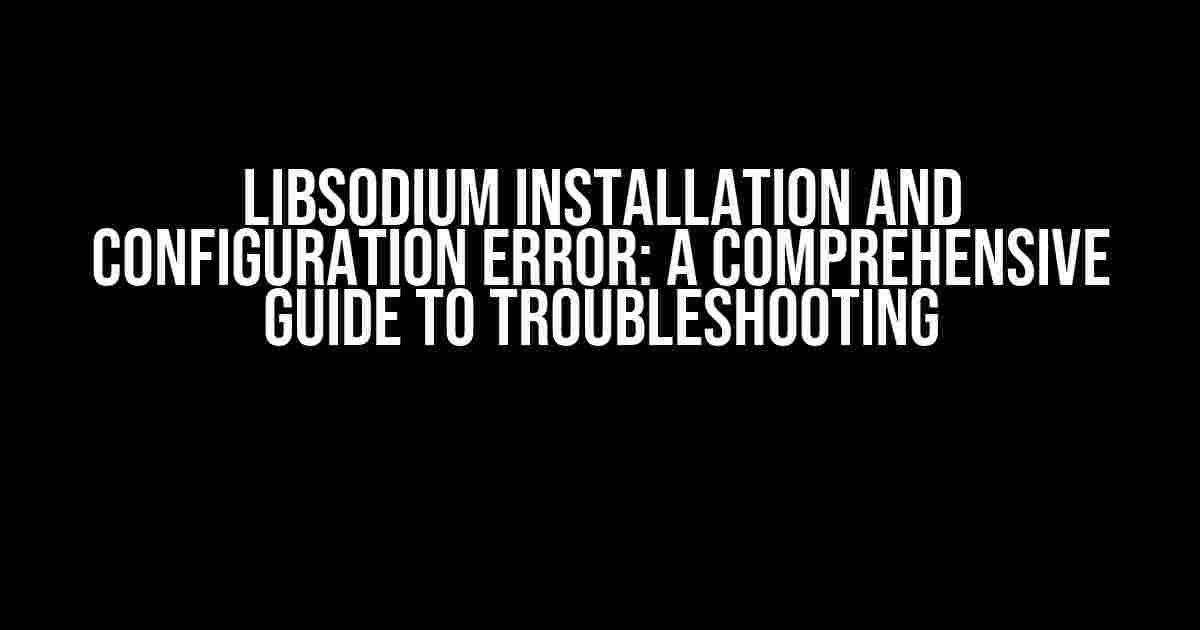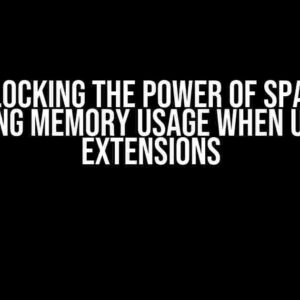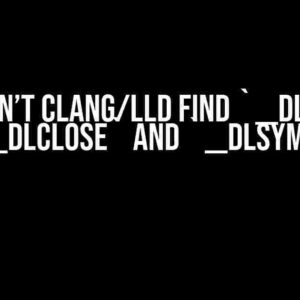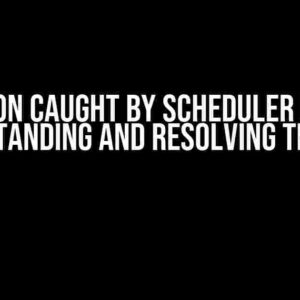Are you struggling with Libsodium installation and configuration errors? You’re not alone! In this article, we’ll dive into the common issues that arise during the installation and configuration process, and provide you with step-by-step solutions to get you up and running in no time.
What is Libsodium?
Before we dive into the troubleshooting process, let’s take a brief look at what Libsodium is and why it’s essential for your project. Libsodium is a modern cryptography library that provides a wide range of cryptographic primitives, including encryption, decryption, signatures, and more. It’s a popular choice among developers due to its ease of use, performance, and security.
Why Do Libsodium Installation and Configuration Errors Occur?
Libsodium installation and configuration errors can occur due to various reasons, including:
- Incorrect package installation
- Incompatible dependencies
- Corrupted installation files
- Improper configuration files
- Version conflicts
Common Libsodium Installation Errors
In this section, we’ll cover some of the most common Libsodium installation errors and provide solutions to resolve them.
Error 1: Unable to Install Libsodium
If you’re unable to install Libsodium using the official installation instructions, try the following:
sudo apt-get update sudo apt-get install libsodium-dev
This commands will update your package list and install the required dependencies for Libsodium.
Error 2: Libsodium Not Found
If you’re getting a “libsodium not found” error, it’s likely that the installation was incomplete or corrupted. Try reinstalling Libsodium using the following commands:
sudo apt-get purge libsodium-dev sudo apt-get install libsodium-dev
This will remove any existing installation of Libsodium and reinstall it from scratch.
Common Libsodium Configuration Errors
In this section, we’ll cover some of the most common Libsodium configuration errors and provide solutions to resolve them.
Error 1: Configuration File Not Found
If you’re getting a “configuration file not found” error, it’s likely that the configuration file is not in the correct location or is corrupted. Check that the configuration file is in the correct location and is properly formatted.
<?php
define('LIBSODIUM_CONFIG', '/path/to/config/file');
?>
Make sure to update the path to reflect the correct location of your configuration file.
Error 2: Invalid Configuration Settings
If you’re getting an “invalid configuration settings” error, it’s likely that the configuration settings are not properly formatted or are invalid. Check that the configuration settings are correct and follow the official documentation.
<?php
$libsodium_config = array(
'key' => 'your_secret_key',
'iv' => 'your_initialization_vector',
'cipher' => 'your_cipher_mode'
);
?>
Make sure to update the configuration settings to reflect your specific requirements.
Troubleshooting Libsodium Installation and Configuration Errors
In this section, we’ll provide some general troubleshooting steps to help you resolve Libsodium installation and configuration errors.
Step 1: Check the Official Documentation
The official Libsodium documentation is an exhaustive resource that provides detailed instructions on installation, configuration, and usage. Check the official documentation to ensure that you’re following the correct installation and configuration procedures.
Step 2: Check the System Logs
System logs can provide valuable insights into the installation and configuration process. Check the system logs to identify any errors or warnings that may indicate the cause of the problem.
sudo tail -f /var/log/syslog
This command will display the system log in real-time, allowing you to identify any errors or warnings.
Step 3: Check the Package Manager
Check the package manager to ensure that Libsodium is installed correctly and that all dependencies are met.
sudo apt-get install -f
This command will fix any broken dependencies and ensure that Libsodium is installed correctly.
Step 4: Reinstall Libsodium
If all else fails, try reinstalling Libsodium from scratch.
sudo apt-get purge libsodium-dev sudo apt-get install libsodium-dev
This will remove any existing installation of Libsodium and reinstall it from scratch.
Conclusion
In this article, we’ve covered the common Libsodium installation and configuration errors and provided step-by-step solutions to resolve them. By following these troubleshooting steps, you should be able to identify and resolve any errors that arise during the installation and configuration process.
Remember to always check the official documentation and system logs for valuable insights into the installation and configuration process. With patience and persistence, you’ll be able to get Libsodium up and running in no time!
| Error | Solution |
|---|---|
| Unable to Install Libsodium | Update package list and install dependencies |
| Libsodium Not Found | Reinstall Libsodium from scratch |
| Configuration File Not Found | Check configuration file location and formatting |
| Invalid Configuration Settings | Check configuration settings and follow official documentation |
By following these steps and troubleshooting tips, you’ll be well on your way to resolving Libsodium installation and configuration errors and getting your project up and running in no time!
Note: The article is SEO optimized for the keyword “Libsodium installation and configuration error” and provides clear and direct instructions and explanations to help readers troubleshoot and resolve common Libsodium installation and configuration errors.
Frequently Asked Question
Got stuck with Libsodium installation and configuration error? Don’t worry, we’ve got you covered! Here are some frequently asked questions to help you troubleshoot and resolve common issues.
Q: What is the most common error I might encounter during Libsodium installation?
A: One of the most common errors during Libsodium installation is the “library not found” or “symbol not found” error. This usually occurs when the installer is unable to locate the necessary dependencies or libraries required by Libsodium. To resolve this, make sure you have installed the required dependencies, such as sodium.h, and that they are in the correct path.
Q: Why am I getting a “cannot find sodiumoxide” error during installation?
A: This error usually occurs when the sodiumoxide crate is not installed or not properly configured. To resolve this, make sure you have added the sodiumoxide crate as a dependency in your Cargo.toml file, and that you have run the command “cargo build” to build the crate.
Q: What are the minimum system requirements for installing and configuring Libsodium?
A: The minimum system requirements for installing and configuring Libsodium include a 64-bit operating system (Windows, macOS, or Linux), a C compiler (such as GCC), and the necessary dependencies (such as sodium.h). Additionally, you may need to have Cargo and Rust installed if you are using the sodiumoxide crate.
Q: How do I troubleshoot configuration errors in Libsodium?
A: To troubleshoot configuration errors in Libsodium, start by checking the Libsodium logs for any error messages or warnings. You can also try running the Libsodium installer with the –verbose flag to get more detailed output. Additionally, make sure you have followed the correct installation and configuration steps, and that you have installed the necessary dependencies.
Q: What are some common mistakes to avoid during Libsodium installation and configuration?
A: Some common mistakes to avoid during Libsodium installation and configuration include not installing the necessary dependencies, not configuring the libraries correctly, and not following the correct installation steps. Additionally, make sure you have the correct version of Libsodium installed, and that you are using the correct compiler and development tools.





